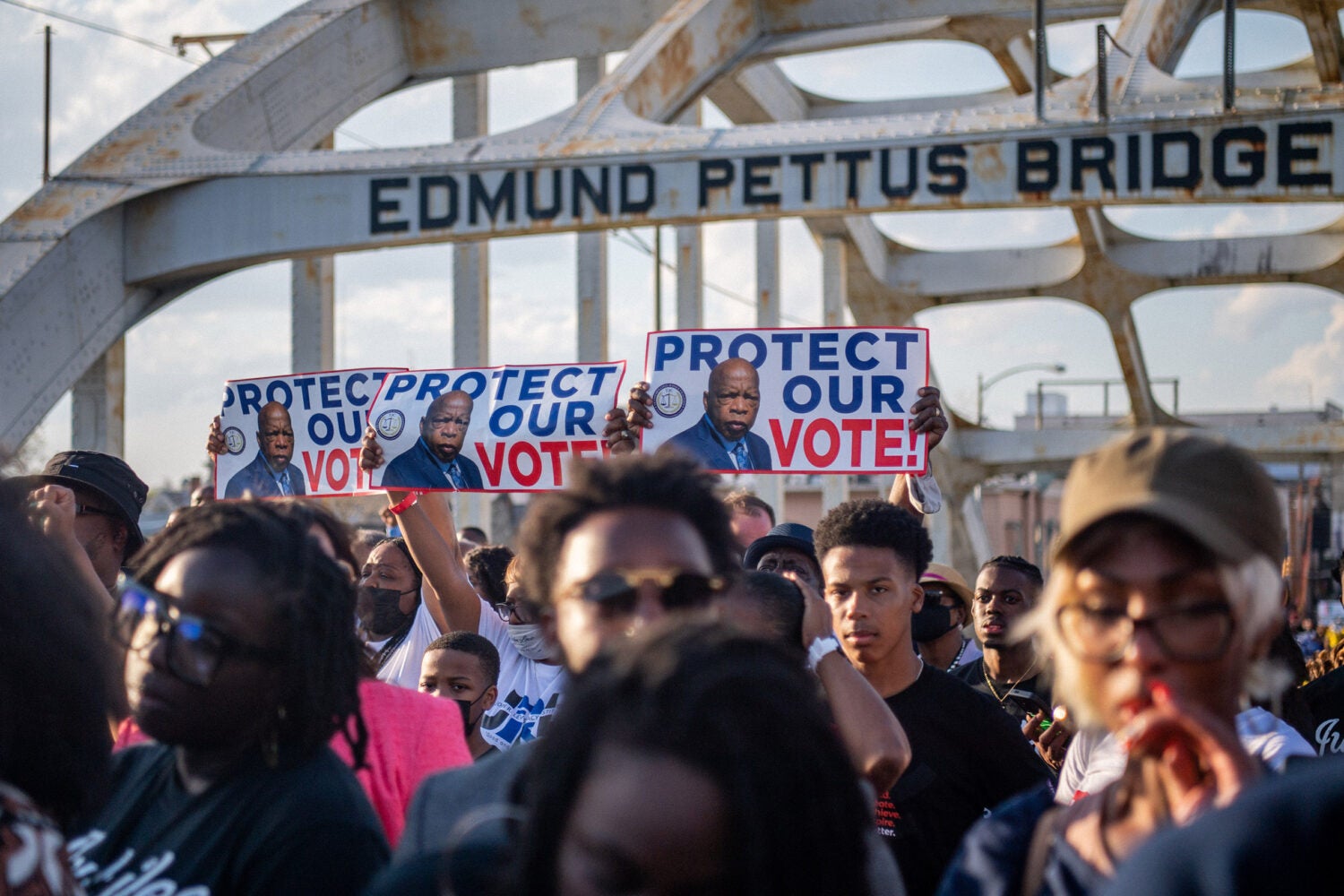On October 4, the U.S. Supreme Court will hear arguments in a case that could decide the future of voting rights for underrepresented minorities around the nation. At immediate issue in Merrill v. Milligan is whether Alabama’s newly redrawn congressional map discriminates against Black voters. Arguing that it does, civil rights advocates filed suit. A federal district court agreed and ruled that the map must be revised to include a new, second district in which Black voters can elect their candidate of choice. In February, the Supreme Court agreed by a vote of 5 to 4 to hear Alabama’s appeal of the lower court’s decision and ordered the original election map to be used in the meantime.
According to election law expert Nicholas Stephanopoulos, the case should be a “slam dunk” under longstanding Court precedent. In a recent article in the Yale Law Journal, he and co-author Jowei Chen also showed that “minority representation would drop substantially under Alabama’s race-blind approach” to redistricting. Harvard Law Today recently spoke with Stephanopoulos, Harvard Law School’s Kirkland & Ellis Professor of Law, about the case, its larger implications for the Voting Rights Act, or VRA, and whether the Court’s February ruling is “another example of the shadow docket run amok.”

Harvard Law Today: Can you provide a little background on the case?
Stephanopoulos: As in previous decades, Alabama drew only one congressional district in which Black voters are able to elect their candidate of choice. However, it’s straightforward to draw two such districts while respecting all state and federal criteria. So, the plaintiffs brought a claim under Section 2 of the Voting Rights Act arguing that Alabama’s district plan constituted unlawful racial vote dilution. Under existing precedent, that claim is a slam dunk. An additional, reasonably compact Black opportunity district can be drawn without difficulty. There’s extreme polarization in voting between Black and white voters. Black voters are underrepresented in Alabama’s congressional delegation. And Alabama has a horrific history of racial discrimination.
HLT: How are the lines of congressional districts typically drawn and by whom?
Stephanopoulos: As in Alabama, the norm is that state legislators draw congressional districts. Because state legislators are about the last people who should be entrusted with redistricting, an increasing number of states have transferred line-drawing authority to independent commissions. The House of Representatives also recently passed a bill (which foundered on the Senate filibuster) that would have required all states to use commissions for congressional redistricting.
HLT: Alabama officials argue that the Supreme Court should permanently reinstate the electoral map originally drawn by the state legislature. Can you summarize their arguments?
Stephanopoulos: Their argument is a frontal attack on the doctrinal framework that courts have used for almost forty years to decide Section 2 cases. They want the baseline relative to which the enacted plan is evaluated to be the usual outcome of a race-blind redistricting process. That usual outcome would be determined using computer simulations that ignore race but satisfy all nonracial criteria. Here, this approach would favor Alabama because the usual outcome of a race-blind redistricting process is a map with zero or one — not two — Black opportunity districts. But this approach is directly contrary to forty years of precedent, which make clear that the relevant baseline is what a race-conscious line-drawer could reasonably accomplish.
HLT: On the other side, civil rights advocates challenging the legislature’s map argue that the Court should uphold the lower court’s judgment that the original plan violates the Voting Rights Act. Why?
Stephanopoulos: Civil rights advocates just want the Court to stick to established precedent, under which this is a very easy case that was rightly decided by the district court. Civil rights advocates also value minority representation in America. As my coauthor and I showed in a recent article, minority representation would drop substantially under Alabama’s race-blind approach.
HLT: The outcome seems to hinge on the Court’s view of Section 2 of the Voting Rights Act, which prohibits voting law resulting “in a denial or abridgment of the right of any citizen of the United States to vote on account of race.” For context, how have the justices ruled in other Voting Rights Act cases in recent years?
Stephanopoulos: The Court has been quite hostile to the VRA in recent years. In Shelby County v. Holder, most famously, the Court neutered the other half of the VRA by holding that its coverage formula (which applied special, stringent requirements to selected jurisdictions) was obsolete. The Court has also narrowed the provision of the VRA at stake in the Alabama case — namely, Section 2 — by holding that it never protects “influence” districts (where minority voters can impact who wins but not elect their preferred candidate) and requires proof that an additional majority-minority district could be drawn. A ruling in Alabama’s favor would be consistent with this trend.
HLT: You and Harvard Law’s Election Law Clinic submitted a friend of the court brief in this case. Why did y’all think it was important to intervene?
Stephanopoulos: As I mentioned, I’ve written the lone article to explore empirically the consequences of Alabama’s race-blind theory. We thought it was important to bring the article’s findings to the Court’s attention. We also wanted to challenge the narrative (which several justices apparently believe) that Section 2 is this incredibly potent provision that’s yielding proportional representation for minorities across the country. In fact, as we show in the brief, there have been few Section 2 cases in recent decades – and the cases that have been brought have usually failed. So, there’s no need for the Court to step in and narrow Section 2 further.
HLT: The Court’s decision in February to temporarily reinstate the legislature’s map pending a full hearing of the case came in response to an emergency application. Some critics might call this an example of deciding an important case through the so-called ‘shadow docket’. Justices Breyer, Kagan, and Sotomayor dissented from that February ruling, as did Chief Justice Roberts in a separate opinion. Was the Court’s decision in that instance in line with past Court practice?
Stephanopoulos: No, this was another example of the shadow docket run amok. The district court’s decision was entirely correct under existing law — as even Chief Justice Roberts, a longtime skeptic of the VRA, conceded in his separate opinion. So, the right procedure would have been to leave the district court’s decision in place for the 2022 election, and only thereafter to consider making fundamental changes to Section 2 doctrine, as urged by Alabama.
